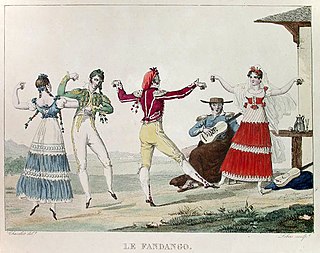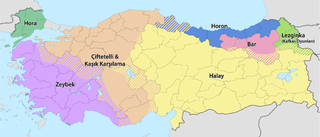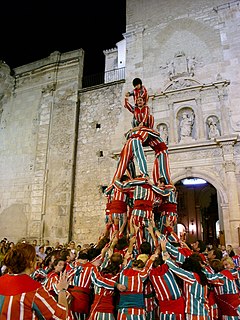 W
WThe bacchu-ber, derived from Occitan bau cubèrt, is a traditional folk dance performed with swords. This dance takes place in the district of Pont-de-Cervières, city of Briançon. Its origin dates back to many centuries ago. This folk dance is unique in France and is one of the rare sword dances that have stood the test of time. It is performed once a year on 16 August, day of Saint Roch (1340–1379), patron of the Pont-de-Cervières district. Similar shows are performed on the Italian side of the Cottian Alps, notably in San Giorio, Fenestrelle and Giaglione villages.
 W
WA barn dance is any kind of dance involving traditional or folk music with traditional dancing, occasionally held in a barn, but, these days, much more likely to be in any suitable building.
 W
WBasque dance is the folk dance by Basque people of Basque Country,
 W
WBergamask, bergomask, bergamesca, or bergamasca, is a dance and associated melody and chord progression.
 W
WThe bourrée is a dance of French origin and the words and music that accompany it. The bourrée resembles the gavotte in that it is in double time and often has a dactylic rhythm. However, it is somewhat quicker, and its phrase starts with a quarter-bar anacrusis or "pick-up", whereas a gavotte has a half-bar anacrusis.
 W
WCéilí dances, or true éilí dances are a popular form of folk dancing in Ireland. Céilí dances are based on heys, round dances, long dances, and quadrilles, generally revived during the Gaelic revival in the first quarter of the twentieth century and codified by the Irish Dancing Commission. These thirty dances form the basis for examination of céilí dance teachers. Irish céilí is a participatory social event attended by both men and women and accompanied by live Irish traditional music.
 W
WA cèilidh or céilí is a traditional Scottish or Irish social gathering. In its most basic form, it simply means a social visit. In contemporary usage, it usually involves dancing and playing Gaelic folk music, either at a house party or a larger concert at a social hall or other community gathering place.
 W
WThe Chapelloise is a traditional folk dance with change of partners, belonging to the standard repertoire of a Bal Folk. Its most common name in France and the French-influenced European Bal Folk scene is Chapelloise, but the dance has many other names too.
 W
WCircle dance, or chain dance, is a style of social dance done in a circle, semicircle or a curved line to musical accompaniment, such as rhythm instruments and singing, and is a type of dance where anyone can join in without the need of partners. Unlike line dancing, circle dancers are in physical contact with each other; the connection is made by hand-to-hand, finger-to-finger or hands-on-shoulders, where they follow the leader around the dance floor. Ranging from gentle to energetic, the dance can be an uplifting group experience or part of a meditation.
 W
WČoček is a musical genre and dance that emerged in the Balkans during the early 19th century. It features prominently in the repertoire of many Romani brass bands.
 W
WA country dance is any of a very large number of social dances of a type that originated in the British Isles; it is the repeated execution of a predefined sequence of figures, carefully designed to fit a fixed length of music, performed by a group of people, usually in couples, in one or more sets. The figures involve interaction with your partner and/or with other dancers, usually with a progression so that you dance with everyone in your set. It is common in modern times to have a "caller" who teaches the dance and then calls the figures as you dance.
 W
WFolk dances and contemporary stage dances of the various ethnic groups in Ukraine.
 W
WDanish folk dance is characterized by being easy going, gentle, and relatively easy to learn. Danish folk dance is mainly a social dance involving groups or groups of couples of dancers, often designed for large gatherings. The dances were supposed to be simple enough for everyone to join in. Danish folk dances are made for social and educational purposes, generally speaking not for exhibitional purposes.
 W
WA deer dance is any of the world's folk dances performed by people dressed as deer.
 W
WAn egg dance is a traditional Easter game in which eggs are laid on the ground or floor and the goal is to dance among them damaging as few as possible. The egg was a symbol of the rebirth of the earth in Pagan celebrations of spring and was adopted by early Christians as a symbol of the rebirth of man at Easter.
 W
WFandango is a lively couples dance originating from Portugal and Spain, usually in triple metre, traditionally accompanied by guitars, castanets, or hand-clapping. Fandango can both be sung and danced. Sung fandango is usually bipartite: it has an instrumental introduction followed by "variaciones". Sung fandango usually follows the structure of "cante" that consist of four or five octosyllabic verses (coplas) or musical phrases (tercios). Occasionally, the first copla is repeated.
 W
WFlamenco, in its strictest sense, is an art form based on the various folkloric music traditions of southern Spain, developed within the gitano subculture of the region of Andalusia, but also having a historical presence in Extremadura and Murcia. In a wider sense, it is a portmanteau term used to refer to a variety of both contemporary and traditional musical styles typical of southern Spain. Flamenco is closely associated to the gitanos of the Romani ethnicity who have contributed significantly to its origination and professionalization. However, its style is uniquely Andalusian and flamenco artists have historically included Spaniards of both gitano and non-gitano heritage.
 W
WKlezmer is an instrumental musical tradition of the Ashkenazi Jews of Central and Eastern Europe. The essential elements of the tradition include dance tunes, ritual melodies, and virtuosic improvisations played for listening; these would have been played at weddings and other social functions. The musical genre incorporated elements of many other musical genres including Ottoman music, Baroque music, German and Slavic folk dances, and religious Jewish music. As the music arrived in the United States, it lost some of its traditional ritual elements and adopted elements of American big band and popular music. Among the European-born klezmers who popularized the genre in the United States in the 1910s and 1920s were Dave Tarras and Naftule Brandwein; they were followed by American-born musicians such as Max Epstein, Sid Beckerman and Ray Musiker.
 W
WHora, also known as horo and oro, is a type of circle dance originating in the Balkans but also found in other countries. Hora retains the Romanian name as it was widespread and known in the world.
 W
WThe hornpipe is any of several dance forms played and danced in Britain and Ireland and elsewhere from the 16th century until the present day. The earliest references to hornpipes are from England with Hugh Aston's Hornepype of 1522 and others referring to Lancashire hornpipes in 1609 and 1613.
 W
WKarsilamas is a folk dance spread all over Northwest Turkey and carried to Greece by Greek refugees. The term "karşılama" means "encounter, welcoming, greeting". The dance is popular on Northwestern areas of Turkey, especially on wedding parties and festivals.
 W
WIn Southeastern Europe, the Serbian traditionally dance the circle dance, known as kolo, named after the circle formed by the dancers.
 W
WThe Muixeranga is the collective name given to the performance of ancient street dances and human pyramids or castells, originating in the ancient Kingdom of Valencia, which are still preserved in the town of Algemesí, 30 km (19 mi) southwest from Valencia, and certain other Valencian towns.
 W
WPolish folk dances are a tradition rooted in ten centuries of Polish culture and history. Many of the dances stem from regional customs and historical events and are distinct from Czech, Slovak and Germanic styles. National dances include formal ballroom or ballet elements. Nowadays, the dances are only performed during major events, holidays or in tourist-oriented public spaces.
 W
WRussian folk dance is an important part of Russian culture. Some of the unique characteristics suggest that many elements were developed by the early Russian population.
 W
WThe Schuhplattler is a traditional style of folk dance popular in the regions of Bavaria and Tyrol. In this dance, the performers stomp, clap and strike the soles of their shoes, thighs and knees with their hands held flat. There are more than 150 basic Schuhplattlers, as well as marches and acrobatic feats that are often interspersed with the basic dance in performance. They may be seen today in Europe and in German immigrant communities around the world. While the Schuhplattler is still largely performed by adults, it has become increasingly popular with youngsters, who love its colorful costumes and its bouncing, leaping, kicking and choreographed horseplay.
 W
WSkočná is a rapid Slavic folk-dance, normally in 24 metre. Czech composers Antonín Dvořák and Bedřich Smetana used this dance, the latter in the third act of The Bartered Bride where it is danced by a circus troupe and is often known as the Dance of the Comedians. Dvořák's 5th, 7th and 11th Slavonic Dances are in the form of the skočná.
 W
WStep dance is a generic term for dance styles in which footwork is considered to be the most important part of the dance and limb movements and styling are either restricted or considered irrelevant.
 W
W"Sur le Pont d'Avignon" is a French song about a dance performed on the Pont d'Avignon that dates back to the 15th century. The dance actually took place under the bridge and not on the bridge.